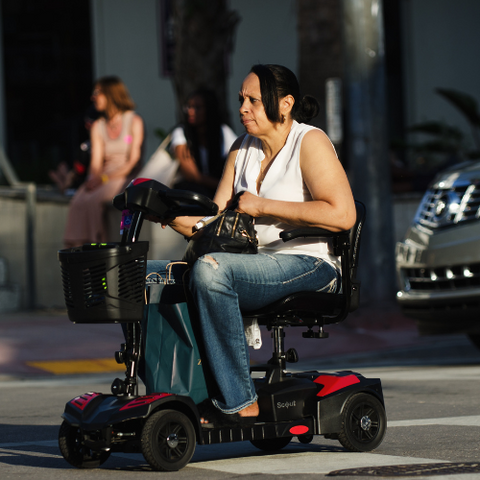Can You Go in Supermarkets with a Mobility Scooter? Exploring Accessibility Policies

For individuals with mobility issues, shopping for groceries or running errands can be a daunting task. However, with the help of mobility scooters, individuals can regain their independence and move around with ease. One of the most common questions people have is whether mobility scooters are allowed in supermarkets.
The answer is yes, mobility scooters are allowed in supermarkets. In fact, many supermarkets have made it a priority to make their stores accessible to individuals with disabilities. Mobility scooters are designed to be used indoors and outdoors, making them an ideal choice for navigating through crowded aisles and tight spaces in supermarkets.
While supermarkets allow mobility scooters, it is important to note that there are guidelines in place to ensure the safety of all shoppers. It is recommended to drive the scooter at a safe speed, be aware of your surroundings, and avoid blocking the aisles. With these precautions in mind, individuals with mobility issues can enjoy a comfortable and hassle-free shopping experience.
Accessibility Laws
People with disabilities have the right to access all areas of a facility where members of the public are allowed to go. This includes supermarkets, grocery stores, and other retail establishments. The Americans with Disabilities Act (ADA) sets the minimum requirements for accessibility in public places.
Under the ADA, businesses are required to make "reasonable accommodations" for people with disabilities. This means that they must remove any physical barriers that prevent people with disabilities from accessing their goods and services. This includes providing ramps, wider doorways, and accessible parking spaces.
For people who use mobility scooters or other power-driven mobility devices, the ADA requires that businesses allow them into all areas where the public is allowed to go. This includes supermarkets and grocery stores. However, there may be some restrictions on where mobility scooters can go within the store. For example, they may not be allowed in stockrooms or backrooms.
It's important to note that while the ADA sets the minimum requirements for accessibility, some states and localities may have additional accessibility laws that businesses must follow. For example, California has its own accessibility laws that are more stringent than the ADA. Businesses must comply with all applicable accessibility laws in their area.
- A study conducted by the National Council on Disability found that people with disabilities are more likely to live in poverty and have lower rates of employment than people without disabilities.
- Another study found that businesses that invest in accessibility measures often see an increase in revenue and customer loyalty.
Businesses that fail to comply with accessibility laws can face legal action and fines. It's important for businesses to understand their obligations under the law and take steps to ensure that their facilities are accessible to all customers.
Citations:
Supermarket Policies

When it comes to mobility scooters in supermarkets, policies can vary from store to store. However, there are some general guidelines and rules that you can expect to encounter:
- Most supermarkets allow mobility scooters inside their stores, but there may be some restrictions depending on the size of the store and the layout of the aisles.
- Some stores may have designated areas for mobility scooters to park while you shop.
- It is important to be aware of other shoppers and staff members around you while using a mobility scooter in a supermarket.
- Some stores may require you to show proof of insurance before allowing you to use a mobility scooter inside.
- It is important to always follow the rules and guidelines set by the store and to be respectful of other shoppers and staff members.
According to a study conducted by the Disability Rights Education and Defense Fund (DREDF), 93% of grocery stores in the United States have at least one accessible entrance, and 80% have accessible parking spaces. However, it is important to note that not all accessible entrances and parking spaces may be suitable for mobility scooters. It is always a good idea to check with the store beforehand to ensure that you can safely and comfortably navigate the store in your mobility scooter.
In addition, the study found that only 35% of grocery stores had accessible shopping carts or baskets for people with mobility disabilities. This can make it difficult for people using mobility scooters to carry their groceries while shopping. However, some stores may offer assistance or alternative options, such as home delivery or curbside pickup, for those who need it.
Overall, while policies and accessibility may vary among supermarkets, it is important to know your rights and to communicate with store staff to ensure a safe and comfortable shopping experience for everyone.
Citation: DREDF
Types of Mobility Scooters
There are several types of mobility scooters available in the market. Each type is designed to cater to specific needs of the user. Here are some common types of mobility scooters:
- Travel scooters: These are lightweight and easy to transport scooters that are designed for people who are always on the go. They are compact and can be disassembled into smaller parts for easy transportation.
- 3-wheel scooters: These scooters are designed for indoor use and are best suited for people who have limited mobility. They are more maneuverable than 4-wheel scooters and can easily navigate through tight spaces.
- 4-wheel scooters: These scooters are designed for outdoor use and are more stable than 3-wheel scooters. They are best suited for people who want to use their scooter on rough terrains and uneven surfaces.
- Heavy-duty scooters: These scooters are designed for people who weigh more than 350 pounds. They have a higher weight capacity and are more durable than other types of scooters.
When selecting a mobility scooter, it is important to consider your specific needs and requirements. A study conducted by the National Institute on Aging found that people who use mobility scooters have a higher quality of life and are more independent than those who do not use them.
Another study conducted by the University of California found that people who use mobility scooters are more likely to participate in social activities and have a better mental health compared to those who do not use them.
It is important to consult with a healthcare professional before purchasing a mobility scooter to ensure that it is the right fit for your needs and requirements.
Citations:
Tips for Shopping with a Mobility Scooter

For those who use mobility scooters, shopping in a supermarket can be a daunting task. However, with a few tips and tricks, it can be more manageable and less stressful. Here are some tips to help you navigate the supermarket aisles with ease:
- Plan your shopping trip ahead of time. Make a list of the items you need, and group them by department to minimize the amount of backtracking you have to do.
- Choose a time to shop when the store is less busy, such as early in the morning or late at night.
- Use the designated areas for mobility scooters and powerchairs. Most supermarkets have wider aisles and designated parking areas for mobility vehicles to make it easier for you to navigate the store.
- Be aware of your surroundings. Watch out for other shoppers and be mindful of your speed and turning radius to avoid collisions or accidents.
- Consider using a basket or cart to help carry your items. Some mobility scooters have baskets or attachments available for purchase to make it easier to carry your groceries.
According to a study conducted by the National Council on Independent Living, individuals who use mobility devices such as scooters or wheelchairs are more likely to experience barriers when shopping in a store. However, with proper planning and awareness, these barriers can be minimized.
Another study conducted by the University of California, San Francisco found that individuals who use mobility devices may experience discrimination or negative attitudes from store employees or other shoppers. It's important to know your rights and advocate for yourself if you encounter any issues while shopping.
By following these tips and being aware of your surroundings, shopping in a supermarket with a mobility scooter can be a more manageable and less stressful experience.
Citations:
Conclusion
Based on our research, it is generally allowed to use mobility scooters in supermarkets and shops in the USA. However, there may be some restrictions based on the size and maneuverability of the scooter, as well as the policies of individual stores.
According to a study conducted by the National Council on Aging, mobility scooters can improve the quality of life for seniors and people with disabilities by increasing their independence and mobility. The study also found that using a mobility scooter can reduce the risk of falls and injuries, as well as decrease the need for caregiver assistance.
It is important to note that mobility scooters are considered pedestrian vehicles, and users are expected to follow the same rules and regulations as pedestrians. This includes obeying traffic signals, using designated crosswalks, and avoiding sidewalks and pedestrian areas that are too crowded or narrow.
If you are planning to use a mobility scooter in a supermarket or shop, it is a good idea to call ahead and check the store's policies and accessibility features. Some stores may offer designated parking spaces and ramps for mobility scooters, while others may have restrictions on the size and type of scooter that can be used inside the store.
- Using a mobility scooter can improve quality of life and reduce the risk of falls and injuries.
- Mobility scooters are considered pedestrian vehicles and users must follow pedestrian rules and regulations.
- Check with individual stores for policies and accessibility features before using a mobility scooter inside.
Overall, using a mobility scooter can provide a safe and convenient way to navigate supermarkets and shops for people with mobility impairments. By following the rules and regulations and checking with individual stores for policies and accessibility features, users can ensure a positive and enjoyable shopping experience.
Sources: National Council on Aging
Meet the Author
Hi there! My name is Samsom Goitom and I am the proud owner of MobilityDepartment.com. As someone who has always been passionate about helping others, I found my calling in the mobility product industry in 2022. Since then, I have been committed to providing high-quality products and exceptional service to my customers.


Leave a comment